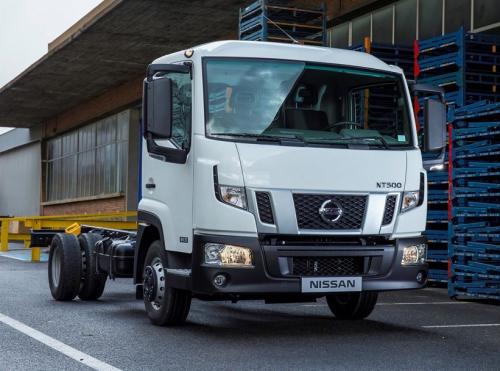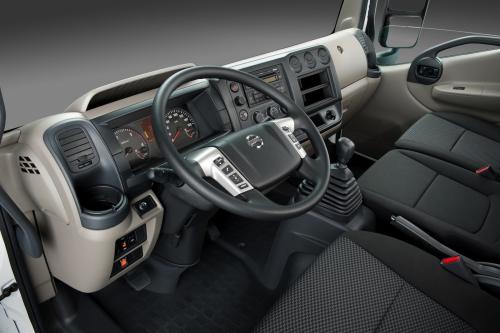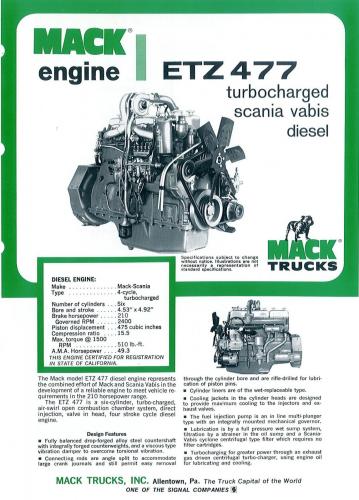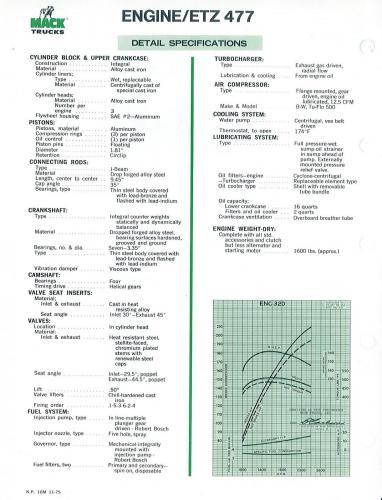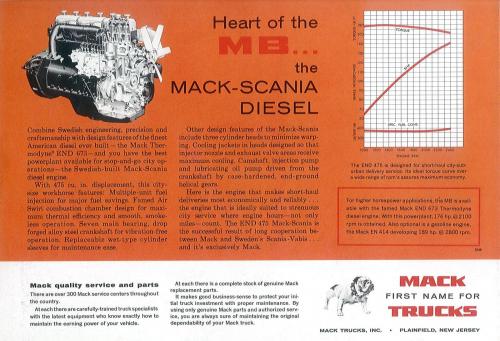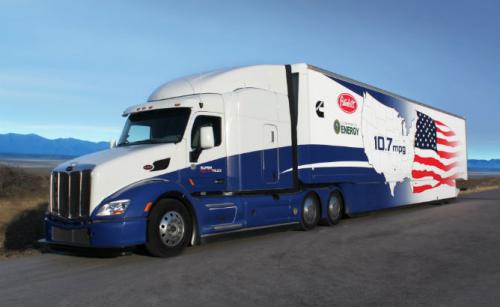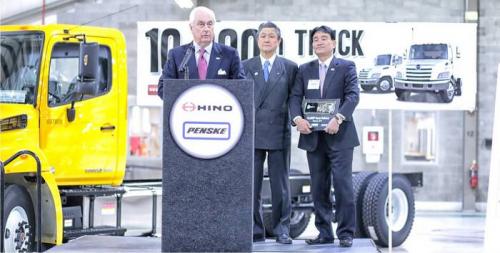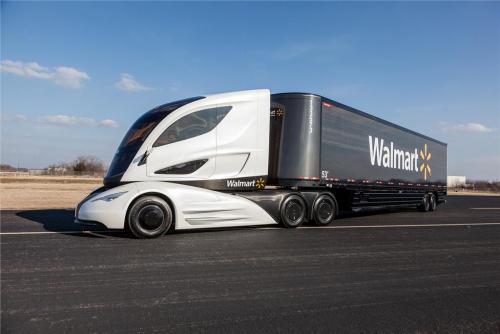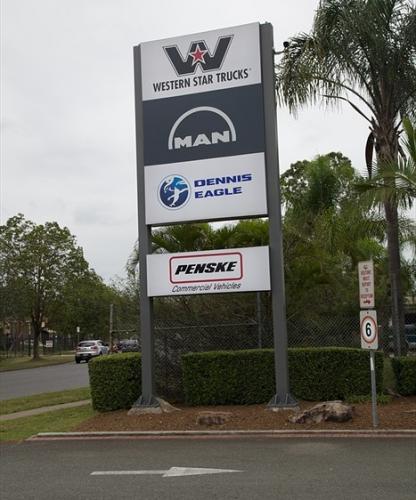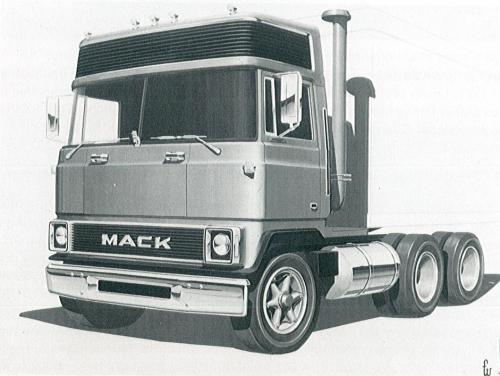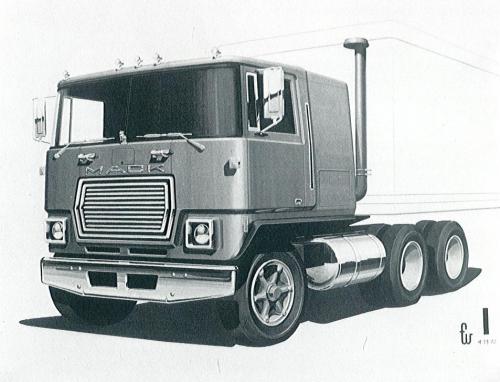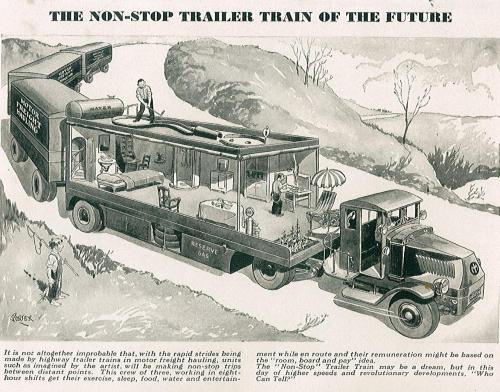
kscarbel2
Moderator-
Posts
17,802 -
Joined
-
Days Won
85
Content Type
Profiles
Forums
Gallery
Events
Blogs
BMT Wiki
Collections
Store
Everything posted by kscarbel2
-
My friend, there is nothing wrong with the Mack Maxitorque T2090. I don't know what age your truck is, but a Mack factory-remanufactured T2090 is upgraded to T300 (2nd generation) components. You won't have any problems with this transmission, and you'll appreciate the deep first gear for low-speed maneuvering. http://www.macktrucks.com/assets/mack/product_specs/t3091361308.pdf
-
Joann Muller / Forbes / February 19, 2014 President Obama painted an ideal scenario Tuesday as he announced his plan to push tough new fuel efficiency standards on everything from heavy-duty pickups to 18-wheeled semi trucks. “Improving gas mileage for these trucks is going to drive down our oil imports even further,” Obama said. “That reduces carbon pollution even more, cuts down on businesses’ fuel costs, which should pay off in lower prices for consumers. So it’s not just a win-win, it’s a win-win-win. We got three wins.” I’m always suspicious when someone tells me everybody wins. And judging by the reaction of independent truck drivers who are already getting squeezed by the cost of regulations enacted a few years ago, they’re afraid they’ll be the big losers. “Each year for the past 10, more and more truckers are squeezed out of the option to buy new equipment because of ever increasing prices due to government requirements that are long on promises but way short on performance,” said Todd Spencer, executive vice president of the Owner-Operator Independent Drivers Association, a trade group of small business trucking companies and professional drivers. “We’re not talking about some 60-watt light bulbs here where poor performance or premature failure is a minor inconvenience. Large trucks are vital tools, essential to our economy and our way of life, and most trucker operators are small-business people just getting by.” OOIDA, which represents 150,000 owner-operators, leased operators and company drivers, says the standards will keep driving up the price of new trucks, forcing truck owners to hold on to older equipment longer and put off buying new trucks and trailers as long as they can. I doubt that’s the outcome Obama is looking for. But the president is committed to finding a way to push his climate change agenda, even without the help of Congress. On Tuesday he asked his administration to draft the new efficiency standards for medium- and heavy-duty trucks by March 2015, with the goal of enacting them a year later. The new rules, governing fuel economy for trucks built after 2018, would follow the first phase of mpg improvements for heavy-duty vehicles in model years 2014 through 2018. According to the EPA, the 2014-2018 standards will add approximately $6,200 to the price of a new truck. The administration has not yet released how much the second round will tack on. But the EPA says an operator of a new semi truck could pay for the technology upgrades required under the current law in under a year and realize net savings of $73,000 through reduced fuel costs over the truck’s useful life. And it argues that savings would flow through to American families, since lower transportation costs can ultimately lower the costs of groceries and other products. Again, I’m skeptical. Show me the money. The American Truck Dealers, a division of the National Automobile Dealers Association, estimates that EPA mandates from 2004 through 2010 added $21,000 to the price of new trucks. Similar efficiency standards for passenger cars and light trucks have already added thousands of dollars to the price of new vehicles. That trend will only continue under the latest rules, which require average fleet fuel economy to reach the equivalent of 54.5 miles per gallon by 2025. There’s no argument the fuel savings is substantial. Since 2008, the unadjusted average test fuel economy of new passenger cars and light trucks sold in the U.S. has increased by about 4 mpg, thanks not only to new regulations but also to consumer demand for better mileage in the face of higher gas prices. Who doesn’t want to save money on fuel and reduce the country’s dependence on foreign oil? Elissa Maurer, a spokeswoman for Navistar, says fuel economy is always top of mind for its customers, which is why Navistar and other truck and engine manufacturers are cooperating with the Environmental Protection Agency and the Transportation Department to draft the next set of standards. Possible solutions include greater efficiency for engines and powertrains, improved aerodynamics, weight reductions, improved rolling resistance for tires, hybrids, automatic engine shutdown and accessory improvements for fans, auxiliary power units and air conditioning. Many of these fuel-saving technologies are not yet in production, and somebody has to pay for them. Jeremy Anwyl, president of consulting firm Marketec Systems, warns that if the tougher standards outpace technology development, costs could skyrocket. “Push the number up suddenly and the costs associated with the increase shoot up,” he said. “But a measured set of increases over a reasonable timeframe can be managed fairly easily.” The Obama Administration would be wise to take it slow when it comes to racheting up fuel efficiency standards or risk triggering unwanted economic consequences.
-
Forgive me, but it sounds like you're trying to go around your elbow to get to your arm. Why not replace your tired T2090 with a Mack remanufactured T2090? That way, you know what you've got (including the latest updates), plus ease of installation (no changes to your current mounting configuration) and the generous warranty. I assume you have an EM6-300R (R = reduced rpm for multi-speed transmissions)
-
Automotive World / February 18, 2014 Nissan is reasserting its intention to become a key player in Europe’s light commercial vehicle sector with the launch of the all-new NT500 medium truck. - All new mid-range truck with robust design - Completely new cab with spacious, comfortable and high quality interior - New engines, transmissions and final drive ratios - GVWs covering 3.5t up to 7.5t - Five wheelbase lengths - Competitive cost of ownership with best-in-class running costs - 36 month warranty period and easy maintenance program - Production has begun at Nissan’s Avila plant in Spain The new NT500 tops Nissan's light commercial vehicle line-up and promises high levels of driver comfort and effective cost of ownership from a versatile and durable chassis cab. It offers a wide variety of wheelbases with gross vehicle weights (GVW) starting at 3.5 and rising to 7.5 metric tons (7,716lb to 16,535lb) and it’s available with two different engines, three transmissions and three model grades. With a modern truck design offering perfect ergonomics, driving comfort and cabin visibility, the NT500 has low running costs and a warranty period of 36 months. Replacing Nissan's “Atleon” model, the NT500′s service maintenance period has been extended from 30,000 to 40,000 kilometers with service-free wheel bearings. With an advanced and functional interior including numerous storage locations, the NT500 has the roomiest cabin in the 3.5 ton segment. Innovations include a multifunctional display, the advanced NissanConnect navigation system, cruise control and Hill Start Assistance. Euro-6 (near EPA2010) ZD30 diesel engines using SCR include a single-turbocharged model rated at 150hp and 350N.m or torque, and a twin-turbocharged model rated at 177hp and 540N.m or torque. Six-speed manual and AMT transmissions are available. The robust new chassis is designed to support straightforward and flawless body mounting. A reinforced frame option is available. FYI: Although Nissan sold its UD (Nissan Diesel) commercial truck unit to Volvo Group in 2007, the company remained in the light end of the commercial truck business under the Nissan brand. The NT500 is the big brother to the NT400 which is sold as the Atlas in Japan and Cabstar in global markets. The Nissan NT500 is also sold to Volvo Group who markets it as the Renault “Gamme D” (D Range). .
-
The turbocharged engine you are speaking of (1975 vintage) would be a 477 (ETZ477), rated at 210 horsepower (Scania-Vabis DS8). This fire apparatus is a model R487F ? Once again, when spec'd appropriately for the application intended, it was a superb engine. Dependable and economical, it was a popular powerplant in its market segment. Incidentally, Scania-Vabis (now simply known as Scania) was one of the first engine makers to furnish a centrifigal oil filter on their engines. The Mack-Scania relationship goes far back. (http://www.bigmacktrucks.com/index.php?/topic/34624-mack-scania-cooperation/) .
-
A 475 would be a non-turbocharged (normally aspirated) Scania-Vabis D8 rated at 140 horsepower. For it's intended purpose, it was a great engine. But that's an engine from the 1960s. .
-
Fleet Owner / February 10, 2014 There’s a remarkably rapid shift away from spec’ing manual gearboxes under way in the medium-duty truck market. The reason is due to how the intersection of human and electronic logic can significantly cut costs for fleet owners. To be sure, fewer and fewer Americans today ever learn to “drive stick.” The upshot is fleets that field medium-duty trucks fitted with automatic or automated manual transmissions (AMTs) are finding it far easier to recruit quality employees as drivers. It’s also less expensive to train these new hires when there’s no manual shifting involved. What’s more, the latest generations of truck-specific automatic and automated transmissions boast sophisticated built-in electronics that boost a truck’s fuel economy and other performance factors that may shrink the initial purchase advantage of manual gearboxes. Viewed from a marketing perspective, the big question is not how much more ground the manual transmission will lose to either ‘smart’ alternative. Rather, it’s how the slugfest for dominance in the medium-duty ring between Allison with its automatic transmissions and Eaton with its AMTs will play out. Sandeep Kar, global director of Commercial Vehicle Research at research and consulting firm Frost & Sullivan, expects “further growth in both automatics and AMTs at the expense of manuals” over the next several years. According to Kar, research indicates that, per 2010 new-truck orders, automatics were more popular in Class 6 trucks than AMTs with the reverse true for Class 7 vehicles. And in both GVW classes, each of those types of transmissions will gain several percentage points by 2017—further cutting into the market share held by manual gearboxes. “The biggest thing driving the shift away from manuals is fuel economy,” he contends. “Non-manual units were once seen as less fuel-efficient, but over the past 10 years technology has changed that. “The shortage of skilled drivers has also had an impact on the market,” he continues. “That includes widening the pool of applicants who are not familiar with manuals” as well as the recognition that “a manual’s impact on fuel economy is only as good as the driver using it.” Kar also points out that the “price-premium gap” between the three transmission types has narrowed in recent years. That gives fleets impetus to look more closely at the lifecycle costs of switching to an AMT or automatic. “Certainly, in such Class 6-7 applications as P&D and regional hauling with a high degree of city driving, not having to shift gears is a bigger draw for drivers,” he remarks. “And as truck OEMs bring to market more integrated powertrains, they will include AMTs in those packages.” Clear shiftIn 2013, about 85% of the OEM’s Class 6-7 vehicles were ordered with an automatic or automated transmission, advises Grant Hummel, medium-duty product manager for Freightliner Trucks. By comparison, he says that back in 2008, about 75% of these were ordered with those transmission choices. “Freightliner sees a future trend towards automated/automatic gearboxes given that driving is not the primary responsibility of the average Class 6-7 vehicle driver—[their role is] to operate the piece of equipment on the back of the vehicle or to deliver whatever product they are hauling,” remarks Hummel. “Fleets are finding that it is much easier to recruit qualified employees through vehicles that are easy to drive. And vehicles equipped with automatic/automated transmissions require considerably less training than those having a manual gearbox.” “About two-thirds of Kenworth’s medium-duty truck lineup is utilizing an automatic or automated transmission today,” states Doug Powell, medium-duty marketing manager. “The trend five years ago was similar to today, but it has grown about 10% [away from manuals] during that timeframe. About 10 years ago, the majority was clearly in manual transmissions. For 2014, I expect the trend to continue to grow a few percentage points [towards automatics and AMTs].” “Approximately 75% of Peterbilt [medium-duty] vehicles were equipped with automatic or automated transmissions in 2013,” says Wesley Slavin, segment manager for medium-duty marketing. “For Peterbilt, the market for automated and automatic transmissions has been relatively steady,” he continues. “They are a good fit for certain market segments and Peterbilt and its dealer network work with customers in those segments to educate them on the advantages.” “Automatic transmissions remain, and are projected to continue to be, popular in the medium-duty market,” advises Elissa Maurer, Navistar’s manager of external communications. “This is related to the cost difference between transmission options and the ease of driver operation.” However, Maurer points out that “while more than 75% of our medium-duty trucks in 2013 were spec’d with automatic transmissions, the trend will continue towards automated [manual] transmissions as price differentials drop.” According to Allison Transmission, its North American market share for Class 6-7 trucks currently stands at 67%—with the other 33% attributed to a combination of AMTs and manuals. It should be noted that Eaton Corp. considers market share information on its AMTs in Class 6-7 trucks as “confidential.” Not surprisingly, OEMs of Class 6-7 trucks are, for lack of a better term, “transmission-neutral,” as they must enable their medium-duty customers to spec automatics or AMTs—not to mention manual boxes, too. Buyer’s choiceTruck makers and their dealers can and do advise their customers on spec decisions based on individual vehicle applications and duty cycles. But in the medium-duty realm, they refrain from endorsing one transmission technology over another. That is unlikely to change—at least until one or more OEMs introduce proprietary powertrains for Class 6-7 trucks that include AMTs. “We currently offer Eaton Fuller automated transmissions and Allison automatic transmissions,” says Peterbilt’s Slavin. “Additionally, we offer the Eaton Fuller Electric Hybrid transmission, which is an automated unit, on select truck models. Automated and automatic transmissions can be spec’d in Peterbilt’s Models 210, 220, 330, 337, 348 and 382.” As Slavin sees it, “depending on application, automated and automatic transmissions offer a variety of benefits. P&D and other stop-and-go applications can enjoy significant advantages through lower service requirements, greater reliability, longer component life and improved fuel efficiency. “There’s also the ease-of-operation factor to consider,” he continues. “That gives companies a much wider driver pool from which to recruit. Most operators are going to be familiar with the automotive feel of an automated or automatic transmission, so they can easily transition from their personal vehicle into the work truck.” Slavin also advises that “since the acquisition cost [for either an AMT or automatic] can be higher vs. a manual transmission, we make sure customers know the lifetime return on investment [ROI] and how these types of transmissions can help them operationally.” He says the OEM and its dealers accomplish that by “analyzing how automated and automatic transmissions may benefit the customer’s bottom line and operations. “Customers can cut costs through fuel savings, improved driver recruitment and retention, and service and replacement of drivetrain components,” Slavin explains. “Additionally, because the transmissions are often easier to operate, drivers can enjoy greater productivity.” “Freightliner Trucks offers a full range of Allison automatic transmissions and Eaton UltraShift/UltraShift Plus transmissions for the M2 106 product, our predominant Class 6-7 vehicle,” says Freightliner’s Hummel. “We have little to no application restrictions for these transmission offerings,” he continues. “Allison and Eaton are able to provide coverage for the vast majority of applications in the market today, through variations of these offerings. Ease of useUltimately, medium-duty truck buyers need to buy the product that is best-suited for their application,” says Hummel. “While ease of driving and optimized shift schedules for fuel economy and performance are certainly strengths of automatic/automated transmissions, there will continue to be demand for manual transmissions in this market, just as there is in the Class 8 on-highway and vocational segments.” “We offer automated and automatic transmissions in our entire medium-duty conventional lineup,” says Kenworth’s Powell. “We see every application utilizing these transmissions today. “Units offered include Allison automatics and Eaton Fuller UltraShift [AMT] models as well as the Eaton Fuller automated hybrid unit,” he continues. “For the Kenworth K270 Class 6 and K370 Class 7 cabovers, we offer only Allison automatics.” According to Powell, driver retention and ease of use are the key drivers for selecting automatic and automated units. “These transmissions drive more like a car and attention can be placed on driving, instead of shifting gears with a manual,” he remarks. “A majority of medium-duty drivers are not typical truck drivers,” says Powell. “If the truck is easy to operate and does not require a CDL, then it will attract more potential drivers. These transmissions also provide a nice residual when the truck is sold. [it’s clear] the trend will continue to swing towards the automatic/automated gearboxes.” “International Trucks currently offers Eaton manual and AMT as well as Allison automatic transmission options for the medium-duty market,” says Navistar’s Maurer. She advises that DuraStar and WorkStar trucks can be spec’d with all three types of transmissions and that the TerraStar model comes with an Allison 1000 Series. “Allison is exclusive on TerraStar and also dominates the utility and municipal markets in DuraStar and WorkStar vehicles,” Maurer notes. As Maurer sees it, “manual transmissions are best suited for fleets with professional drivers as they offer more efficient power transfer. Manuals also offer better fuel economy, but that is dependent on the experience of the driver.” She notes that Navistar finds automatics are more popular in lease/rental applications “where drivers tend to be inexperienced rental customers. Though automatics can be less fuel efficient, by eliminating driver errors, automatics can result in better fuel economy depending on the application. “Automated transmissions,” Maurer contends, “provide the advantages of automatics and manuals—more efficient power transfer and automatic shifting of gears. “The biggest features on [non-manual] transmissions are the electronic shift controls, which allow mounting flexibility and various power take-off options for the control and power of body-mounted equipment,” she notes. “Customers looking to buy a new truck should consider the intended application and factor in driver experience and fuel economy to determine the best transmission option for them,” Maurer advises. Allison Transmission and Eaton, of course, have their own thoughts to offer on which transmission option a fleet moving away from manuals should select—automatic or AMT. According to Lou Gilbert, Allison’s director of North America marketing, when selecting a medium-duty transmission, “consideration should always be given to overall lifecycle value. That’s made up of driver-skill requirements, training and retention; transmission durability; maintenance costs and uptime; fuel economy; vehicle productivity, and resale value.” He adds that the “medium-duty market acceptance of the Allison products enforce the proven value delivered through each of these variables.” Allison’s Gilbert notes that the market is moving away from manuals within Class 4-5 and Class 6-7 especially for lease/rental, P&D, school bus and various service and landscaping applications. “Because very few automobile models are being offered with a manual transmission, many of the newer [truck] drivers are younger and do not possess manual-shifting skills,” remarks Bill Gross, Eaton’s emerging products sales manager. “This is especially so in the Class 6 market, where a driver may not be required to hold a CDL. “Because the commercial-vehicle industry in the U.S. continues to struggle to find drivers with the requisite skills to effectively drive a manual,” he continues, “Eaton believes automated manual transmissions have grown in popularity.” Duty cyclesGross points out Eaton’s approach is “to find ways to develop solutions for our customers to allow them to manage power more effectively, including automated manual transmissions.” According to Gilbert, the “Allison 1000 and 2000 Series product families are the primary models in the Class 4-5 and Class 6-7 space. The Allison 3000 Series also applies to some Class 7 vehicles. “Fully automatic transmissions are the primary architecture in these truck classes due to reliability, durability and driver ease,” he contends. “Additionally, the 1000, 2000 and 3000 Series deliver the fuel efficiency and shift quality these medium-duty customers demand.” Gilbert describes the common key features of Allisons as “full-power shifts which improve drivability and fuel usage, a torque converter that provides improved driver satisfaction, improved launch capability and overall smooth vehicle operation, and outstanding software and calibration features that target improved fuel economy. These features are designed to target specific operational characteristics—duty cycles—of medium-duty truck applications.” He says these duty cycles are characterized by “the components of acceleration, deceleration, cruise and stop. Duty cycles vary by how much time is spent in each of these components. Class 4-5 and Class 6-7 duty cycles spend the majority of their time accelerating and decelerating due to the stop-and-go requirements and city operation and Allison designs features into its transmissions that target each duty cycle component to improve fuel use.” Medium-duty spec’ing trends “include equipping trucks with fully automatic transmissions to retain, recruit and satisfy drivers, especially as the availability of qualified manual-transmission drivers continues to decline,” says Allison’s Gilbert. What’s more, he contends that “the automated manual transmission’s ‘power interrupts’ and inconsistent drivability are not appealing to this market. The attributes of the Allison transmission provide the most value to the medium-duty market. “Reducing engine horsepower and torque is also an expected trend,” he continues, “as fleets continue to look for ways to cost-reduce their vehicles and maintain productivity. Allison’s full-power shifts and torque converter will always provide superior acceleration compared to any other transmission architecture.” Gilbert adds that “when a fleet manager chooses to purchase an engine with a little lower horsepower/torque rating, the Allison transmission is the obvious choice to ensure vehicle productivity.” “For the Class 6-7 commercial vehicle market, we developed a model called the Eaton Fuller UltraShift HV Series,” advises Eaton’s Gross. “The HV has been available since 2006 and is a five- or six-speed transmission with the sixth speed being overdrive rated up to 660 lbs.-ft. torque. “The HV is approved for various vocations in this market space and is sold today through Daimler Truck North America, Kenworth, Navistar and Peterbilt dealerships,” he continues. “It has standard PTO openings as well as optional ‘park pawl’ models.” Service pointsAccording to Gross, the HV Series advantages include being “an automated [manual] transmission that performs its work in ‘automatic fashion’ and that has shown fuel improvement over torque-converted [automatic] transmissions at various fleets. “In addition,” he continues, “the HV has no lube filters, so there are no lube filters to change, and its factory-fill Roadranger lube has a 500,000-mi. change interval, making it virtually ‘lubed for life.’” Gross says the transmission also comes standard with PTO openings. “That means a dealer stock order can be ordered in confidence for added sales flexibility without knowing who may purchase the truck. This PTO standard feature is also important for the ‘second’ owner, who may want a PTO depending on its use.” He also points out that the HV Series “can be serviced by any local dealership, which can provide quicker uptime for the customer, and the transmissions are backed by our Roadranger support—the most trusted name in commercial vehicles. We believe our leadership, our products’ added value and our service support sets us apart in the marketplace today.”
-
DTNA Optimistic on 2014 After Strong January
kscarbel2 replied to kscarbel2's topic in Trucking News
Daimler optimistic after strong January truck ordersFleet Owner / February 18, 2014 One month does not make a trend, but exceptionally strong new truck orders in January are "very encouraging," according to David Hames, GM of marketing and strategy for Daimler Trucks North America. Preliminary Class 6 through 8 order numbers for the first month were the highest recorded since 2006, not just for DTNA, but across the board, he said at a press briefing. "Some of the things that need to happen [in the economy] are starting to line up for the first time and we're very optimistic, though we know how fragile the recovery has been," Hames said. A return to huge sales peaks like those seen in 2006 aren't likely as fleets are exhibiting prudent discipline with capacity expansion, according to Hames. "We're seeing more purchases based on business requirements. not the speculative truck purchases of past." While the sales recovery is welcome, "if this [January order] trend continues, it could present capacity issues [for suppliers] going forward," Hames said. Asked about the source of the orders, Hames characterized them as "broad based and strong." The January orders were not coming from DTNA's top 25 accounts, but rather were dealer based, representing a return to the market for smaller fleets, according to Mark Lampert, Sr. VP of marketing and sales. "The mega fleets already have the newest equipment out on the road," Lampert said. "Smaller fleets and vocational operations have been out of the market for a while. But those who made it through the downturn are now coming back to the market." -
Transport Topics / February 19, 2014 Daimler Trucks North America, which achieved nearly a 40% market share in 2013, expressed optimism about the coming year following a strong January. David Hames, general manager of marketing and strategy, said orders during the first month of 2014 totaled 13,343 — the highest since 2006. “The U.S. economy is set to accelerate, and we’re optimistic,” Hames said. He and other executives met with reporters here Feb. 18 during a presentation to spotlight the Freightliner brand. Portland, Ore.-based DTNA garnered 38.2% of heavy-duty market share last year, the company said. Hames cited the popularity of the Freightliner Cascadia Evolution model, which is providing greater fuel efficiency, and said the company’s Detroit DD15 engine is in high demand. “Our testing shows 5% to 7% fuel economy improvement,” Hames said of the Cascadia. The vehicle has been in production for 11 months. During its test phase, the company learned from drivers that refueling had changed because they were able to drive longer distances. “They were getting that much more fuel economy out of it,” Hames told Transport Topics. “That’s how orders rose for January.”
-
Obama Sets Deadline for Trucks' Fuel-Efficiency Standards
kscarbel2 replied to kscarbel's topic in Trucking News
UPDATED: Obama says next stage truck fuel efficiency standards will “save thousands” Fleet Owner / February 18, 2014 President Obama today directed the Environmental Protection Agency (EPA) and the National Highway Traffic Safety Administration (NHTSA) to come up with new “next stage” fuel efficiency for heavy- and medium-duty trucks by March 2105, calling such standards the key to “saving thousands of dollars every year” in reduced fuel costs for trucking companies larger and small. “This is not just a ‘win-win’ but a ‘win-win-win’ – three wins – in terms of driving down oil imports for our nation, reducing carbon pollution, and saving money for both businesses and consumers,” the President said in a speech at Safeway grocery chain distribution center in Upper Marlboro, MD. “In 2011 we set new fuel efficiency standards for trucks and in my state of the union speech three weeks ago I said we’d build up on that,” President Obama noted. “The goal off these new fuel economy standards is to take us into the next decade like cars … so trucks use less oil, save money, and reduce pollution.” The new “post-2018” standards will go beyond mandates crafted by EPA and NHTSA back in 2011 that are being applied to model year 2014-2018 light, medium, and heavy-duty trucks. A fact sheet released by the administration ahead of the President’s speech explained that the two agencies are expected to issue Notice of Proposed Rulemaking (NPRM) for the new “next-stage” fuel efficiency and greenhouse gas (GHG) standards by March 2015, with a final rule to be issued by March 2016. The administration added that EPA and NHTSA will also work closely with stakeholders, both large and small, to explore further opportunities for fuel consumption and emissions reductions beyond the model year 2018 time frame, as well as with the California Air Resources Board (CARB) with the goal of ensuring that the next phase of standards allow manufacturers to continue to build a single national fleet. The American Trucking Associations (ATA) is reacting positively yet cautiously to the President’s latest effort to mandate fuel economy improvements for heavy- and medium-duty trucks. “Fuel is one of our industry’s largest expenses, so it makes sense that as an industry we would support proposals to use less of it,” noted Bill Graves, ATA’s president and CEO, in a statement. “However, we should make sure that new rules don’t conflict with safety or other environmental regulations, nor should they force specific types of technology onto the market before they are fully tested and ready.” “Trucking is a very diverse industry,” stressed ATA Chairman Phil Byrd, president of Bulldog Hiway Express. “As such, whatever standards the administration sets should reflect that diversity and whatever tests are devised should accurately reflect what drivers face on the roads every day.” By contrast, the Consumer Federation of America (CFA) believes that fuel efficiency improvements for big trucks could save the average American household $250 dollars per year in the cost of consumer goods and services. “We know that the fuel costs associated with shipping goods cross country heavily impact the price of everything from a carton of milk to a pair of shoes. Achievable standards that cut fuel use by nearly 5% would put $29.5 billion dollars back into the pockets of Americans,” said Mark Cooper, CFA’s director of research; a figure drawn from the group’s recent report Paying the Freight: The Consumer Benefits of Increasing the Fuel Economy of Medium and Heavy-Duty Trucks. “Consumers also pay the cost of commercial transportation fuel in the price of the goods and services they buy,” Cooper added. “As such, reducing the energy consumption of big truck fleets will have a positive impact on household expenditures.” The Heavy Duty Fuel Efficiency Leadership Group (HDFELG), an informal collection of fleets and other industry participants formed back in 2010, is also endorsing the President’s “next-stage” fuel efficiency rule plan. “Finalizing new fuel efficiency standards for medium and heavy duty trucks will be an important milestone that should result in significant benefits to our economy, the trucking industry and the environment,” noted Douglas Stotlar, president and CEO of Con-way Inc. and HDFELG member. “This collaborative approach will result in realistic, achievable goals and an effective regulatory framework to improve fuel efficiency and reduce greenhouse gas emissions.” Dick Giromini, president and CEO of trailer-maker Wabash National Corp., added that for the first time, fuel efficiency and greenhouse gas emissions rules will likely cover the “trailer” part of tractor-trailers, setting standards designed to ensure that trailers contribute to better fuel efficiency and cuts in greenhouse gas emissions. “We look forward to working with the EPA and the Department of Transportation, as well as our customers and industry partners, to achieve new standards that result in greater fuel efficiency and environmental benefits in the years ahead,” he said. President Obama noted in his remarks that this latest effort to further improve heavy and medium-duty truck fuel efficiency is due to the “important economic role” performed by such vehicles. “While heavy duty trucks account for just 4% of the vehicles on our highways – though I know when you are out there driving it feels like far more – they are responsible for 20% of our [vehicle] carbon pollution and 20% of one road fuel consumption,” he said. “Yet trucks carry over 70% of our nation’s freight – from flat screen TVs and diapers to fresh produce. So every mile per gallon better they get, that means thousands of savings every year for truckers and consumers.” -
Wall Street Journal / February 18, 2014 Cummins and Peterbilt announced today that the latest version of their SuperTruck demonstration tractor-trailer achieved 10.7 mpg last month under real-world driving conditions. Developing a truck that could meet or exceed 10 mpg when fully loaded was considered unlikely, if not impossible, just a few years back, with most trucks averaging between 5.5 and 6.5 mpg. However, with advances in engines, aerodynamics and more, SuperTruck has proven that 10 mpg is attainable. SuperTruck averaged a 75 percent increase in fuel economy, a 43 percent reduction in greenhouse gas (GHG) emissions and an 86 percent gain in freight efficiency in 24-hour, head-to-head testing against a 2009 baseline truck -- all significant improvements. The Cummins-Peterbilt SuperTruck was on display today for President Barack Obama's announcement of firm deadlines for the next generation of national fuel-efficiency and GHG emissions standards for heavy-duty commercial vehicles. The goal of the SuperTruck program, initiated by the U.S. Department of Energy (DOE), is to improve long-haul Class 8 vehicle freight efficiency. The program focuses on advanced and highly efficient engine systems and vehicle technologies that meet prevailing emissions and Class 8 tractor-trailer vehicle safety and regulatory requirements. In addition to the benefits of reduced fuel consumption and petroleum usage, the improvements in engine system efficiency will deliver a significant reduction in GHG emissions. Cummins has partnered with Peterbilt Motors Co. for the SuperTruck project. The project objectives have included development and demonstration of a highly efficient and clean diesel engine, an advanced waste heat recovery system, an aerodynamic tractor and trailer combination and a lithium ion battery-auxiliary power unit, to reduce engine idling. The Cummins-Peterbilt SuperTruck uses the Peterbilt Model 579, with best-in-class aerodynamic efficiency. The engine, based on Cummins industry-leading ISX15, converts exhaust heat into power delivered to the crankshaft, and has electronic control software that uses route information to optimize fuel use. The SuperTruck also includes chassis refinements, improvements in the aerodynamics and other significant advances in the engine. Lightweighting throughout the tractor-trailer also enables increased freight efficiency. Eaton, also part of the Cummins-Peterbilt SuperTruck project team, is developing a next-generation automated transmission (AMT) that improves fuel efficiency in heavy trucks. Eaton's contribution includes the design, development and prototyping of an advanced transmission that facilitates reduced engine-operating speeds. Cummins and Eaton jointly designed shift schedules and other features to yield further improved fuel efficiency. This demonstration of the Cummins-Peterbilt SuperTruck has exceeded DOE goals for freight efficiency -- a key trucking metric based on payload weight and fuel efficiency expressed in ton-miles per gallon. The SuperTruck achieved an 86 percent improvement in freight efficiency and a 75 percent fuel economy improvement over a 24-hour test cycle in December 2013. The program goal was a 68 percent freight-efficiency increase over a 2009 vintage baseline vehicle of the same weight traveling along the same route. "We are honored that the Cummins-Peterbilt SuperTruck has been chosen to be on display for President Obama's announcement," said Wayne Eckerle, Cummins Vice President - Research and Technology. "The SuperTruck clearly demonstrates the technologies that can deliver significant fuel-efficiency improvements over the next decade and beyond as we continue to develop for cost and performance attributes that will make them strong commercial successes." Landon Sproull, Peterbilt Chief Engineer, agreed. "The work we're doing on SuperTruck is very much in keeping with Peterbilt's global reputation for industry-leading design, innovative engineering and fuel-efficient solutions," he said. "I think it's been a terrific opportunity for us to look into the future and demonstrate what's possible." "Eaton's collaboration with Cummins and Peterbilt on the SuperTruck program reflects our commitment to develop highly integrated and optimized powertrains to help reduce fuel consumption and emissions," said Thomas Stover, Chief Technology Officer - Eaton Vehicle Group. "The critical need to increase the fuel efficiency will require the role of the transmission to grow significantly within the sphere of powertrain optimization, and as a leader in power management solutions, Eaton is at the forefront of innovation in this important area." The Class 8 Peterbilt Model 579, powered by a Cummins ISX15 engine, achieved 10.7 mpg during testing last month between Denton, Texas, and Vernon, Texas. The 312-mile route was the same one used two years ago, when the first version of the Cummins-Peterbilt SuperTruck averaged just under 10 mpg. The testing in both instances was conducted on a round-trip basis, to negate any wind advantage that might have been gained by traveling one way, and each tractor-trailer had a combined gross weight of 65,000 lb running at 64 mph. A longer, 500-mile route between Denton and Memphis, Texas, was also used to demonstrate the vehicle's fuel-efficiency improvement over a 24-hour test cycle. The increase in fuel economy for the Cummins-Peterbilt SuperTruck would save about $27,000 annually per truck based on today's diesel fuel prices for a long-haul truck traveling 120,000 miles (193,121 km) per year. It would also translate into a more than 43 percent reduction in annual GHG emissions per truck. The potential savings in fuel and GHGs are enormous, given that there are about 2 million registered tractor-trailers on U.S. roads today, according to the American Trucking Association. Cummins is a prime contractor leading one of four teams under the DOE's SuperTruck project, one of several initiatives that are part of the 21st Century Truck Partnership. The partnership is a public-private initiative to further stimulate innovation in the trucking industry through sponsoring by government agencies, companies, national laboratories and universities. Cummins, Peterbilt and their program partners will have invested $38.8 million in private funds over the four-year life of the SuperTruck program when it draws to a close later this year. The project received critical support in matching grants from the DOE's Vehicle Technologies Program. More info: http://www.hybridcars.com/cummins-peterbilt-supertruck-posts-10-7-mpg/ .
-
Trailer/Body Builders / February 18, 2014 Hino Trucks held a ceremony at Hino's plant in Williamstown, West Virginia, to commemorate the delivery of the 10,000th Hino truck to Penske Truck Leasing (PTL). "We congratulate the entire team at Hino and Toyota on this significant milestone," said Roger Penske, Chairman of Penske Truck Leasing. "Hino continues to be a trusted supplier of high-quality trucks within our truck leasing and truck rental fleets. We are pleased with the performance of these vehicles and the outstanding support Hino provides." The 10,000th truck is a 2015 model 268A, which is part of Hino's class 6 & 7 conventional truck line up that is specifically suited for the lease and rental market segment where Hino has grown to 10 percent of the market. The 10,000th truck will be a part of Penske Truck Leasing's commercial rental fleet. "This major milestone began in 2004 when PTL received its first Hino 268 truck. We are proud of our longstanding partnership with PTL and the delivery of our 10,000th Hino truck, a significant accomplishment for both companies. We are excited to mark this achievement and look forward to continuing to provide PTL with best in class trucks," said Yoshinori Noguchi, President & CEO for Hino Trucks.
-
Transport Topics / February 18, 2014 Wal-Mart Stores Inc. unveiled a concept tractor-trailer Feb. 17 during a meeting to report on progress in meeting the company’s sustainability goals. The Wal-Mart Advanced Vehicle Experience (WAVE) features a microturbine hybrid power train and the first-ever trailer made from lightweight carbon fiber, plus a radically designed truck cab in which the driver sits in the center of the vehicle with electronic controls on either side and an entry door that slides open. Vendors who helped assemble the vehicle, which company officials are calling Jetson, include Peterbilt Motors Co., Great Dane Trailer and Capstone Turbine Corp. Chris Sultemeier, senior vice president and head of corporate transportation services for Wal-Mart, said the company also has agreed to buy 2,000 hydrogen-fueled forklift trucks for use in its U.S. and Canadian distribution centers. In 2005, Wal-Mart set a goal of doubling the efficiency of its truck fleet by 2015. Sultemeier said the company has reached 80% of its goal by buying more fuel-efficient trucks and finding ways to ship more goods in less space and using fewer trucks. In Canada, Wal-Mart is testing a super-high-capacity tractor trailer that carriers 40% more merchandise than a standard 53-foot tractor-trailer. The Bentonville, Ark.-based company also is testing vehicles that run on waste grease and natural gas, plus several models that use diesel and hybrid-assist technologies to reduce fuel consumption. Wal-Mart ranks No. 4 on the Transport Topics’ Top 100 Private Carriers list with more than 6,500 tractors and over 61,000 trailers. Video: http://www.youtube.com/watch?v=jvt7ptICxSY More info: http://www.theblaze.com/stories/2014/02/18/see-the-futuristic-concept-truck-walmart-wants-to-use-to-maximize-efficiency-on-the-road/ .
-
Dealers order more than 8,000 diesel-powered Ram 1500s in 3 days
kscarbel2 replied to kscarbel2's topic in Trucking News
The ZF 8HP eight-speed is a great transmission. As for the engine, it's actually designed and produced by V.M. Motori, not Fiat Powertrain Technologies (FPT). Motori is now a wholly-owned Fiat subsidiary, but operates with autonomy. This engine is already out in the 2014 Grand Cherokee, and will be available in the 2015 Wrangler. The FPT engines in the Iveco heavy trucks, the Cursor 9, 11 and 13, are all solid performing powertrains. -
Automotive News / February 18, 2014 Chrysler Group dealers ordered more than 8,000 diesel-powered Ram 1500 pickups in the first weekend that they could do so -- a figure that represents nearly half of the light-duty pickup's normal monthly production. Included in the orders placed between Feb. 7 and 10 were more than 400 diesel-powered half-ton pickups that had already been sold to customers. That's about five times the normal percentage of sold orders for a typical prelaunch vehicle, said Bob Hegbloom, director of the Ram brand. "This just helps to solidify in our minds that we did the right thing with this truck," Hegbloom told Automotive News today. Chrysler began building its first salable Ram 1500s with a 3.0-liter V-6 EcoDiesel engine late last month at its Warren Assembly plant in suburban Detroit. Those pre-spec vehicles are due to be delivered to dealers in the next three weeks. The company disclosed plans to sell a diesel-powered light-duty pickup almost a year ago. The percentage of initial diesel orders by dealers is about double or triple what brand executives had anticipated, Hegbloom said. While demand is likely to taper off as dealers receive unsold inventory, Hegbloom said that in coming months, presold orders will be given production priority to keep customer wait times down. "Our anticipation is that there's going to be some ongoing demand for this powertrain," Hegbloom said. The diesel engine is made by Fiat subsidiary VM Motori S.p.A. in Italy. It produces 240 hp and 420 pounds-feet of torque and is mated in the Ram 1500 to an eight-speed (ZF) automatic transmission.The diesel engine's exhaust is treated with urea (SCR) to reduce emissions of oxides of nitrogen, which causes smog. The onboard urea tank must be refilled every 10,000 miles. The Ram 1500 EcoDiesel is the first light-duty, diesel-powered, full-sized pickup to be offered in North America since General Motors sold them in the mid-1990s. Ram brand head Reid Bigland estimated that diesel versions will account for as many as 30 percent of Ram 1500 sales. The Ram 1500 EcoDiesel starts at $30,465, including shipping. The price is $2,850 higher than a similarly equipped Ram 1500 with a 5.7-liter Hemi V-8 engine, the company says. Because dealers have not yet received any Ram 1500 EcoDiesels, it's difficult to tell whether the retailers will tack on an additional premium over the sticker price to take advantage of hot demand. Hegbloom said that he hoped they wouldn't, because the diesel-powered Ram is "an opportunity to conquest competitive brands, and if dealers don't treat new customers right, they're going to lose them." Chuck Eddy, chairman of the Chrysler National Dealer Council, said he ordered three times his monthly allocation of diesel-powered Ram 1500s, just to make sure he didn't run out. "Everybody's gung-ho about it," said Eddy, owner of Bob & Chuck Eddy Chrysler-Dodge-Jeep-Ram near Youngstown, Ohio. "The factory's just not going to have enough to go around, at least for a while."
-
Obama Sets Deadline for Trucks' Fuel-Efficiency Standards
kscarbel2 replied to kscarbel's topic in Trucking News
The US and Europe are attempting to move too far and too fast with truck exhaust emissions. Also, it’s time for the U.S. to join the entire rest of the world and use the Euro emissions standards. If the entire world from tomorrow was Euro-3 (roughly EPA1998), we could all breath clean air. Euro-3 is extremely clean. Compared to the trucks of the 1970s, Euro-3 is light years ahead. And yet, it is a reasonable balance of clean emissions, reliability and fuel economy. The Euro-3 engine's electronically-controlled high pressure common rail fuel injection system is a vast improvement of the old American and Robert Bosch in-line fuel pump, allowing for significantly reduced emissions. EPA2007 and EPA2010 were/are an experiment at the expense of heavy truck operators. In the interest of cooperation, I'd be willing to accept standardizing on Euro-4 emissions levels (roughly EPA2004), if accomplished with SCR, a reasonably reliable and trouble-free technology. The decision to reach EPA2007 with heavy EGR was a costly mistake (experiment). It should have been accomplished with a combination of SCR and light EGR. -
In India, they're still running Cummins B series engines in many heavy trucks. It's a poor market, but still with heavy truck needs. With care, the trucks get the job done. The China market is maturing at an amazing speed, and overloading is beginning to be controlled. But still, most of the trucks are run hard. Ten plus years ago, the 6-7 liter engines did have short 3 year lives. However the technology level of chinese heavy trucks has ramped up at a staggering rate. Today's 9 to 13 liter engines approach the durability of the global brand heavy truck engines.
-
Ultraliner/MH6XX
kscarbel2 replied to Terry T's topic in Antique and Classic Mack Trucks General Discussion
Great Thread. I only wish it was under the Modern Mack discussion rather than the Antique thread. When you consider the Freightliner Argosy 2, Kenworth K200 and International 9800i sold today (in global markets), an updated Ultra-Liner or a totally evolved Ultra-Liner II would be a far superior truck. The Ultra-Liner was extremely advanced in engineering, and arguably the safest COE cab design still to this day. The Ultra-Liner could easily have been developed forward to remain a cutting edge product in the global COE market. -
Diesel News / February 18, 2014 Talking to an audience of analysts and journalists at the earnings call for the Penske Automotive Group in the USA this week, company chairman and CEO Roger Penske spoke on the company’s move into Australia after the purchase of the of Transpacific’s Commercial Vehicle Group, which imports and sells the Western Star, MAN and Dennis Eagle brands in Australia. The organization is now known as Penske Commercial Vehicles. “Turning to Penske Commercial Vehicles, the fourth quarter reflected our first full quarter of operations for the commercial vehicle business and we continue to be very pleased with the initial results,” said Penske. “For the fourth quarter, the commercial vehicle business generated approximately $100 million in revenue. The heavy duty truck markets sold 11,000 units in Australia last year and our brands represented 11.7 percent market share.” “We also have a 10.3 percent market share in the Australian bus market. We believe this business is a tremendous opportunity for the company to grow revenue profitability, while further diversifying the overall footprint of our business.” “I think we remain opportunistic in the U.S. we also look at brands and where we have scale, as we’ve been in Australia, we were there last week, there was lots interest coming to us on the automotive side, I think we run the play with commercial vehicles here for a while before we jump into retail auto but there is a lot of opportunity there.” .
-
Sure, the software is naturally slightly different, because the Mack brand has their Maxidyne, Econodyne and Maxi-Cruise power profiles as opposed to Volvos. But the engines are the same. You mentioned EGR coolers. They are the same, painted a different color. (For example, as shown on the Volvo and Mack EGR cooler replacement bulletins below for the D13/MP8. The exact same service bulletin, just a different brand name in the upper left corner). http://www.volvotrucksemedia.com/ProductDetail.aspx?ProductId=7419&GroupId=-1 Click on "View File" https://www.macktrucksemedia.com/ProductDetail.aspx?ProductId=7440&GroupId=-1 Click on "View File" These engines run the exact same Volvo SCR system with a light to heavy EGR rate of 18% to 28%.
-
In situations like this with smaller displacement engines that would inherently have unacceptably low engine braking performance, I'll spec a ZF transmission with their integrally mounted retarder. . http://www.youtube.com/watch?v=VXQPPTvx4Ew http://www.zf.com/corporate/en/products/product_range/commercial_vehicles/trucks_intarder.shtml
-
It’s always interesting to revisit how the future direction of truck design was imagined at certain points of time. GM was always leaning into the future throughout the 1950s and 1960s, not only in car and truck design, but also in the home (Frigidaire). The Bison III and Turbo Titan III were great examples. http://www.bigmacktrucks.com/index.php?/topic/31891-the-gas-turbine-general-motors-bison-iii/ http://www.bigmacktrucks.com/index.php?/topic/31898-the-gas-turbine-chevrolet-turbo-titan-iii/ But sadly, no new products were in the pipeline for GMC Truck during the 1970s aside from the General. The Astro and Brigadier languished on And Ford certainly was stepping forward with Big Red. http://www.bigmacktrucks.com/index.php?/topic/32038-fords-futuristic-gas-turbine-big-red/ This was the era when American could do anything. We led the world in innovation. We even thought that we could put a man on the moon.......and did. What has happened to the country we once knew, where foreign truckmakers now dominate our heavy truck market?
-
In Brazil, VW has an impresssive 30 percent market share. While their largest offering there is 8.9 liters, Scania is there with all engine sizes, as is DAF, Ford, Iveco, Mercedes-Benz, Navistar and Volvo. Still the average engine size is 9-11 liters. In China, 11 liters is now the norm and 12-13 liter engines are selling. In a few years, they'll have 15-liter powerplants. Remember, you can always get around cubic inches with gears and low (high numerically) axle ratios. The Indian market and China 10+ years ago were classic examples of that.
BigMackTrucks.com
BigMackTrucks.com is a support forum for antique, classic and modern Mack Trucks! The forum is owned and maintained by Watt's Truck Center, Inc. an independent, full service Mack dealer. The forums are not affiliated with Mack Trucks, Inc.
Our Vendors and Advertisers
Thank you for your support!



